Today, cervical osteochondrosis has become much younger. The reason for this is considered to be an improvement in living conditions, a significant decrease in mobility during work and rest, and a craze for fast food. They lead to metabolic imbalances and increase trauma to the intervertebral cervical disc even with minor physical exercise or shock.

Therefore, it is not surprising that there are many requests on the Internet - osteochondrosis of the cervical spine: symptoms and treatment. We present a brief overview of these questions, because they are always individual, and a vertebrologist or neurologist can answer them only during an appointment.
Characteristics of the disease
With osteochondrosis of the neck, the disc of the intervertebral space is destroyed. Usually, they perform the function of shock absorbers and protection.
Located between the vertebrae, they prevent the vertebral bodies from touching each other. When walking and more active movements, they can compress, giving flexibility to the spine. In addition, due to the disc-ligamentous apparatus, a path is created for the nerves exiting the spinal cord.
When the discs and ligaments are destroyed, the vertebrae begin to rub against each other. Friction causes pain and other discomfort in the neck. When the vertebrae approach each other, the nerves become pinched, and additional symptoms appear in the parts of the body where the affected neurons are responsible. Neurological symptoms occur.
Osteochondrosis can affect any part of the spine, and the symptoms will vary. Disk destruction can occur in several areas at once.
A greater amount of load falls on the lumbar spine, which means that the discs and ligaments here are most often subject to changes. But it is osteochondrosis of the cervical region that causes the most suffering in humans. After all, the main channel for blood supply to the brain runs through the neck, and there are many nerves and nerve endings.
Statistics show that the cervical region is most often affected. Of all the parts of the spine, it is the most mobile. On the video on the Internet you can see how the disease develops and its complications.
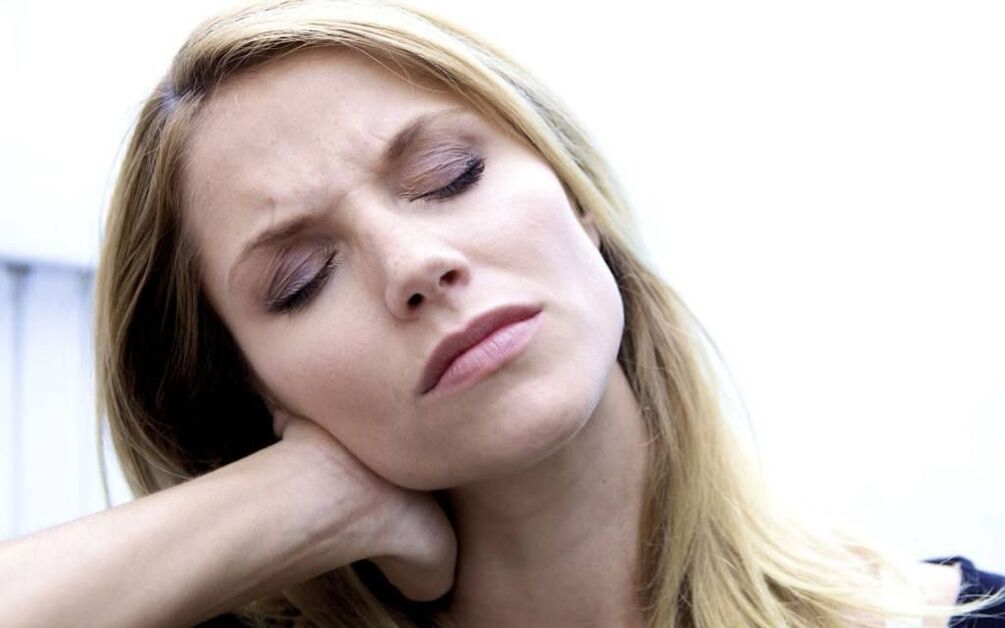
The symptoms of cervical osteochondrosis in women are basically no different from the symptoms that occur in men. There is one difference: the most common symptom of the disease in women is headache.
Cause
The classic causes of the development of cervical osteochondrosis include:
- low mobility, lack of sufficient physical activity;
- disturbances in metabolic processes;
- salt deposits, especially in the cervical area;
- unbalanced diet;
- incorrect body position while working at the computer, driving a car or during other static activities.
If you have a tendency to develop joint disease or salt deposits, the risk of getting disease from an unhealthy lifestyle increases.
Classification of clinical manifestations
Osteochondrosis of the cervical spine, pathological symptoms and treatment are closely related, but complex therapy is prescribed only after instrumental clarification of the diagnosis. Currently, there is the following classification of manifestations.
Radicular syndrome or cervical radiculitis
Radicular syndrome is a medical term for a group of symptoms that occur as a result of a pinched nerve root located between the vertebrae of the neck. At first, such compression manifests itself in the form of paresthesia - numbness, tingling sensations and the feeling of "goosebumps" all over the skin.
Ignoring and not treating such manifestations leads to further development of the disease. Acute pain (quick or delayed) occurs, which develops into a chronic pain syndrome.

The characteristics of the manifestations of cervical radiculitis depend on the localization of the degenerative process, i. e. between which vertebrae the nerve root is pinched:
Irritation-reflex syndrome
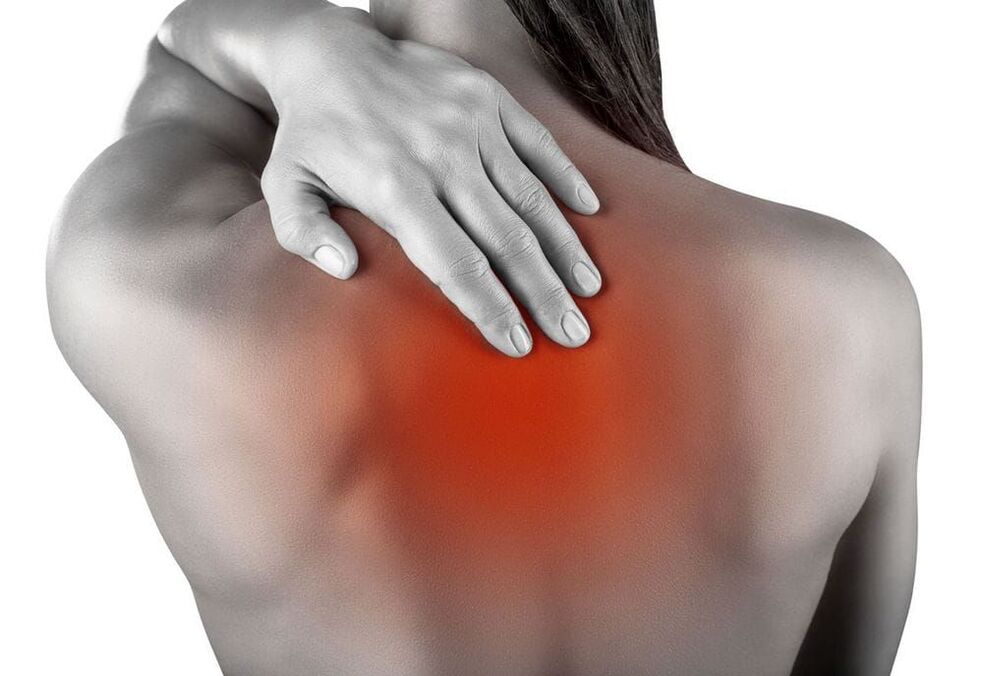
Pain in irritation-reflex syndrome when the roots of the lower cervical vertebrae are pinched occurs between the shoulder blades.
This syndrome is characterized by diffuse, sharp burning pain in the neck, back of the head, or upper back. It occurs after sleep, or during the beginning of movement after holding a long static position. It is possible that the pain will radiate with pain to the heart or shoulder joint.
Vertebral artery syndrome
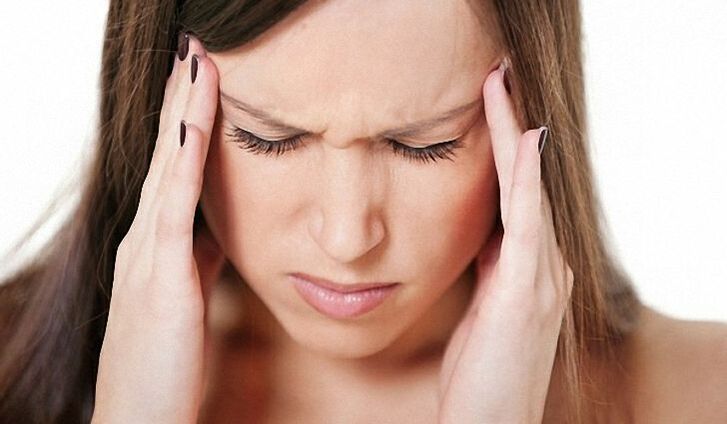
Osteochondrosis of the cervical and thoracic spine, symptoms (and its treatment) can manifest as signs combined into Vertebral Artery Syndrome:
- headache - like a point, throbbing or burning, spreading diffusely;
- place of localization - above the eyebrows, at the temples, the crown of the head, at the back of the head;
- the pain is constant, but sometimes occurs in the form of attacks;
- the severity of pain increases after the first movement from a static position;
- in weak people, nausea may develop, movement coordination may be impaired, and dizziness and fainting may occur;
- Possible decrease in hearing and visual acuity, "rabbits" in the eyes, tinnitus, snoring.
On the note! Often, the only sign of neck osteochondrosis is pharyngeal symptoms. These include: pain, dryness and/or difficulty swallowing. However, the cost of ignoring such symptoms can be enormous. These symptoms exist in some inflammatory diseases that can develop into cancer.
Cardiac syndrome
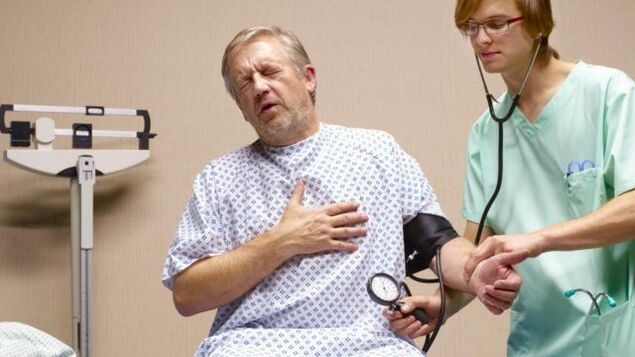
Early diagnosis of cervical spine osteochondrosis is often complicated by the presence of cardiac syndrome in the patient.
It is characterized by:
- increased heart rate;
- attacks or prolonged pain in the heart area, which is often mistaken for angina pectoris;
- Chest pain worsens after sudden movement or heavy lifting.
That is why, if angina is detected, an experienced doctor will send the patient to take an X-ray of the cervical and thoracic vertebrae, because with a parallel diagnosis of cervical osteochondrosis, the symptoms and treatment at home will be specific.
For example, vertebrologists are responsible for warning patients that if "heart pain" is not relieved by nitroglycerin or other coronary dilator drugs, then they should not be taken several times in a row in a short period of time. It is enough to drink ibuprofen or nurofen forte.
For your information! There are other ways in which you can distinguish a true angina attack from a painful coronary syndrome. With the latter, the patient can walk quickly.
Minor symptoms
Nausea
Nausea and belching are the result of blood circulation problems in the brain. Often patients associate these symptoms with mistakes in nutrition, begin to limit the amount of food they eat, and make changes to their diet.
Nausea and belching in themselves can reduce appetite. All these phenomena lead to the fact that a person begins to lose weight, and the balance of nutrients in the body is disturbed.
An attack of nausea can end in vomiting, which also occurs with careless turning of the head, bending of the body, or vigorous physical activity. In this case, poor circulation leads to insufficient nutrition of the inner ear and balance center.
Shortness of breath
The feeling of lack of air occurs when the phrenic nerve is pinched in the cervical region of the spine. This important nerve is an element of the cervical plexus and regulates the depth of breath and the frequency with which respiratory movements are made.
The patient complains of difficulty breathing with all his might. Shallow breathing leads to a decrease in the concentration of oxygen in the blood, shortness of breath occurs, and in severe cases, shortness of breath occurs.
At night, breathing may stop, often occurring together with snoring attacks. Night problems are provoked if a person lies in an uncomfortable position and the head and neck are not in the anatomically correct position.
If this problem is accompanied by unsatisfactory cleanliness of the room where a person sleeps, when the room is poorly ventilated, dusty and there is no clean air flow at night, the patient experiences hypoxia. Lack of oxygen occurs in all body tissues, waking up the patient will not feel rested
Tinnitus feeling
Tinnitus occurs due to problems with the blood supply to the vestibular apparatus. Blood vessels go there through the cervical vertebrae of the spinal column.
Disorders in the inner ear cause the sensation of various sounds:
- background hissing sound;
- ringing, squeaking.
Such a complex of complaints is usually called cochlear syndrome or cochlear.
Important: if the patient does not consult a doctor with these symptoms, then over time a decrease in hearing acuity occurs.
Patients often think that the disorder is associated with the auditory analyzer itself. Even doctors can find it difficult to understand the condition, especially if there are no obvious signs of osteochondrosis.
However, when there is a problem with the vertebrae, there are certain hearing symptoms. Osteochondrosis of the cervical vertebrae can be distinguished by the characteristics of its occurrence, so the sound arises when a person remains in one position for a long time.
Throat problem
Often osteochondrosis can be felt only through the complex of pharyngeal symptoms:
- Sore throatoccurs independently of food intake, you can detect the difference between the appearance of symptoms and sudden movements of the head and neck.
- Sensation of a foreign body in the throatappear and disappear.
- There are complaints of itching and dry throat, a strong unpleasant sensation can trigger the patient's desire to cough. Coughing will cause dryness and itching. These complaints are the result of damage to both nerve fibers and blood vessels at the same time.
Important: such symptoms can be observed with inflammation in the area of the cervical vertebrae and with the occurrence of tumors.
Sight problem

Impairment of visual function is less common; it occurs more often in people with atherosclerotic lesions of the head vessels and with a general decrease in pressure.
The vessels that supply the eye also run through the cervical vertebrae with their osteochondrosis, the following complaints arise:
the appearance of "lids" on the eyes; decreased clarity and visual acuity; the appearance of black dots or rods; difficulty focusing on a particular subject.
Symptoms are not constant. Patients notice that vision sometimes worsens and sometimes improves.
A distinctive symptom of osteochondrosis is the inability to influence the state of vision with the help of glasses, drugs and gymnastics. Elimination of symptoms is possible only after treating the cause of the problem.
Loss of consciousness
Impaired blood supply to the brain can cause loss of consciousness or fainting. This occurs when blood flow to the brain is temporarily interrupted.
In this case, clamping does not necessarily occur in the cervical region, only irritation by the deformed vertebral structure is sufficient. In response to this effect, significant spasms occur in the arteries.
Consciousness returns to a person quickly. This is facilitated by changing the position of the body. An unconscious person must be placed in a horizontal position with their legs elevated. In this way, the blood from the lower part of the body will help to restore the blood supply to the suffering brain.
As a rule, such short-term conditions do not bring complications or consequences. If the disruption of blood flow to the brain is stronger, then the consequences are possible.
Important: after losing consciousness, the patient must see a doctor to undergo an examination and prevent repeated attacks.
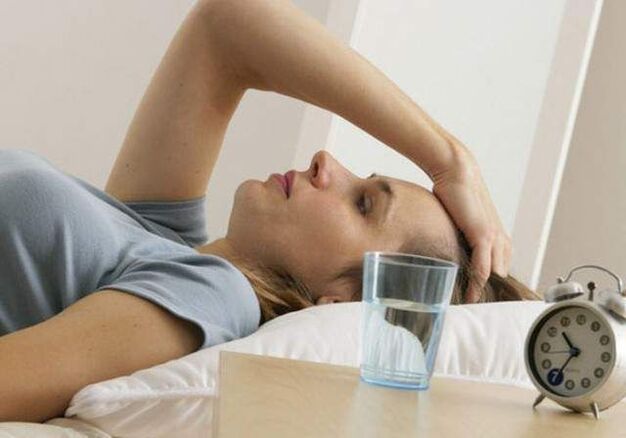
Despite the short duration of the condition, a person who loses consciousness should call an ambulance.
Blood pressure problems
The presence of osteochondrosis in the cervical spine causes a spike in blood pressure. For people past middle age and the elderly, this can be very noticeable. This is due to the fact that the center responsible for the vascular response to changes in the external environment is located in the brain and also suffers from insufficient blood supply.
The presence of irritating factors in the form of deformed vertebrae worsens the situation. This is how VSD symptoms arise against the background of cervical osteochondrosis. Depending on a person's tendency, a hypertensive or hypotonic crisis occurs. Often one type of crisis gives way to another.

Temperature fluctuations
Temperature fluctuations are not specific symptoms of osteochondrosis. If the body temperature rises, this means that a focus of infection or a neoplasm has arisen in the body. The immune system reacts in the form of temperature.
However, the patient may feel heating and even burning of the skin in the problem area, that is, along the back of the neck.
When several symptoms combine, a person begins to feel unwell. General health worsens, mood drops, irritability and indifference arise. For patients with severe pain or blurred vision, it becomes difficult to perform daily tasks and carry out productive work activities.
Important: if any complaint, even if it is not related to problems with the spine, prevents you from leading a normal normal lifestyle, then you should see a specialist as soon as possible and determine the cause of concern.
Danger of disease
Cervical osteochondrosis poses a great danger, because the area affected by it is the most important vascular passage that supplies the brain and spinal cord with many nerve branches. All symptoms of osteochondrosis have a significant negative impact on the patient's well-being and quality of life.
But this disease has life-threatening complications:
- Intervertebral hernia is considered the next stage in the development of osteochondrosis. It occurs in the absence of treatment. People who suffer from neck or back pain for a long time without seeing a doctor receive such a diagnosis.
- Compression of the spinal cord processes causes damage to them, and radiculopathy develops. Along with this, growths and osteophytes form on the vertebrae. All this threatens the patient with loss of mobility and sensitivity of the area where the affected nerve fibers are responsible.
- One of the most dangerous complications is vertebral artery syndrome with cervical osteochondrosis. This artery supplies important parts of the brain - the medulla oblongata and the cerebellum. When this vessel is compressed by osteochondrosis, ischemia of the spinal cord and brain occurs. There is a risk of the condition ending in a stroke.
- If the disease is not treated for many years, in the presence of vertebral deformities, there is a possibility of damage to the spinal cord itself, which is located in the spinal column. The cost of lack of treatment is life-threatening organ injury.

If a person finds worsening symptoms of cervical osteochondrosis, he should consult a specialist as soon as possible. Vertebral deformation can cause severe trauma to the spinal cord, and this is very dangerous for a person.
Treatment of cervical osteochondrosis
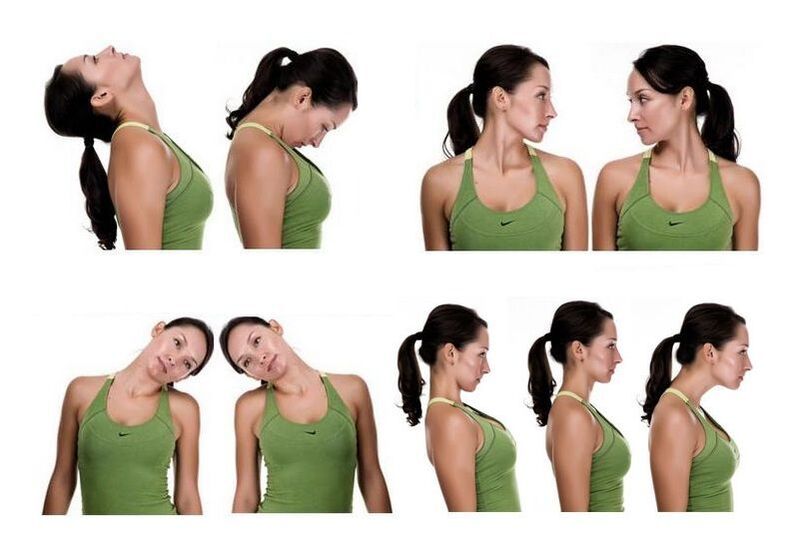
Symptoms and treatment of cervical osteochondrosis at home require the approval of a treating specialist. The video in this article with a set of exercises for the neck muscles is not posted. There are many of them on YouTube.
However, you should know that the instructions for exercise therapy with this diagnosis prohibit:
- jogging;
- perform any jumping movements;
- pumping the muscles of the shoulder girdle and neck with dynamic exercise, especially with weights or resistance.
Important! If there is an exacerbation of cervical osteochondrosis, symptoms and treatment with physical exercises, self-massage and physiotherapeutic procedures are suspended. In the acute period, visiting a chiropractor is also prohibited. Rest and drug therapy with painkillers or non-steroidal anti-inflammatory tablets and ointments are indicated.
Treatment of cervical osteochondrosis with folk remedies is not very effective and may be an additional method of therapy at the recovery stage. However, vertebrologists praise treatment with leeches and absolutely do not recommend treatment with bee stings will also help with therapy.
Allergy is a dangerous disease, an event that is impossible to predict, and an acute allergic reaction - Quincke's Edema can cause anaphylactic shock and be fatal.
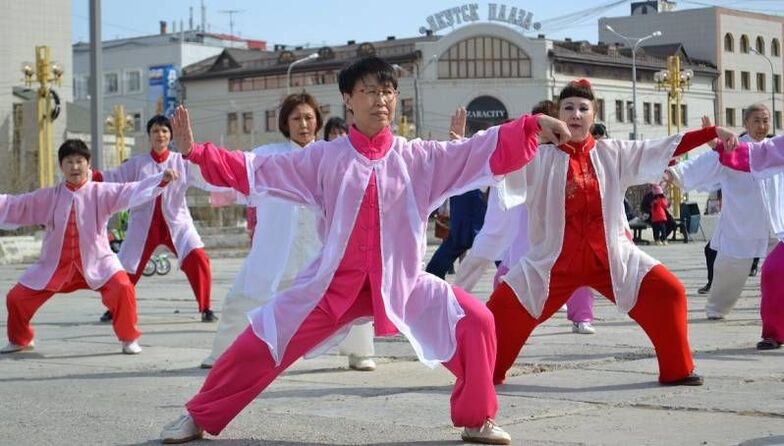
Among the non-traditional methods for the treatment of cervical osteochondrosis, we can recommend:
dynamic and static yoga classes; Wushu, Taiji and Qigong gymnastics; acupuncture and Su-Jok.
In addition to daily physical exercises, it is necessary to give up bad habits, monitor your daily drinking regimen and balance your diet, and also do special morning exercises for osteochondrosis in the lumbar region. The weekly menu should include raw and half-cooked vegetables, fresh seasonal fruits, fermented milk drinks and daily meals.
Natural diet type meat and fish from the herring or salmon family should be eaten every day. Replace coffee and tea with rosehip decoction and natural juice.
Treatment of cervical osteochondrosis is a long process that will not take months, but years. Osteochondrosis cannot be cured, but significant remission can be achieved. The result depends only on the patient himself, his perseverance in following the recommendations and maintaining a healthy and active lifestyle.
Frequently asked questions
What are the symptoms of osteochondrosis of the cervical spine?
Osteochondrosis of the cervical spine can manifest itself as pain in the neck, shoulders, arms, dizziness, tinnitus, numbness or tingling in the arms, and limited neck mobility.
How can you treat osteochondrosis of the cervical spine at home?
To relieve the symptoms of osteochondrosis of the cervical spine, you can use relaxation methods, exercises to strengthen the neck muscles, massage, warm compresses, and the use of pain-relieving ointments and gels.
What exercises help with cervical spine osteochondrosis?
To strengthen the neck muscles and relieve the symptoms of cervical spine osteochondrosis, stretching and strengthening exercises for the neck muscles, head rotation, bending and twisting the neck, as well as exercises to improve posture are useful.
Useful tips
Tip #1
For osteochondrosis of the cervical spine, it is recommended to do special exercises to strengthen the neck and back muscles. This will help improve blood circulation and reduce pressure on the spine.
Tip #2
You can use cold compresses or hot compresses to relieve pain and reduce inflammation. Cold helps reduce swelling, while heat increases blood circulation and relaxes muscles.
Tip #3
It is important to monitor your posture and avoid being in an incorrect position for long periods of time. Taking frequent breaks to stretch and adjust your work position can reduce stress on the cervical spine.






















